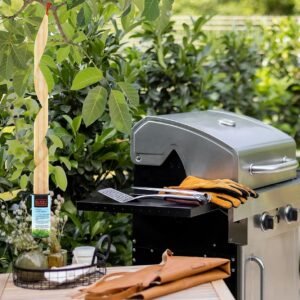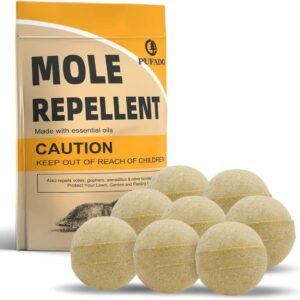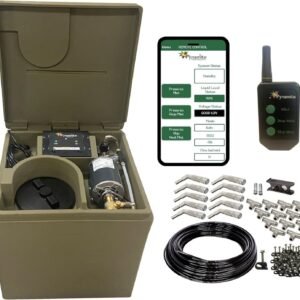How To Tell If Powder Post Beetles Are Active
If you’ve ever noticed tiny holes appearing in the wooden surfaces of your home or furniture, you might have a problem with powder post beetles. These pesky insects can cause significant damage to wood, making it crucial to identify their activity early on. In this article, we’ll explore some simple yet effective ways to determine if powder post beetles are active in your surroundings. By familiarizing yourself with these methods, you’ll be better equipped to protect your property and take appropriate measures to eliminate these unwelcome guests.
How To Tell If Powder Post Beetles Are Active
Inspecting for Powder Post Beetles
When it comes to dealing with powder post beetles, a thorough inspection is the first step in addressing the issue. By knowing what to look for, you can determine whether or not these pesky insects are present in your wood. Here’s a breakdown of what you need to inspect for:
Look for small exit holes
One of the telltale signs of a powder post beetle infestation is the presence of small exit holes in the wood. These holes are typically round and can range in size from as small as a pinhead to about 1/8 inch in diameter. It’s important to note the location of these holes and the quantity you find, as this will help with further evaluation.
Check for powder-like frass
Frass refers to the powdery residue left behind by powder post beetles as they tunnel through the wood. This fine powder is actually a mixture of wood particles and the beetles’ excrement. When inspecting for frass, look for it near the exit holes. It may appear as a light dusting or accumulation around the openings. The presence of frass indicates that the beetles are actively feeding and breeding within the wood.
Observe damaged wood
Another important aspect of your inspection is to closely examine the wood itself for signs of damage. Powder post beetles create tunnels and galleries as they feed on the wood, which weakens its structure. Look for visible signs of tunneling, such as trails or channels that run through the wood. Additionally, keep an eye out for any cracks or splits on the surface, as these may be caused by the beetles’ activity.
Search for adult beetles
While it may be more challenging to spot adult powder post beetles, observing their presence can provide valuable information about the extent of the infestation. Adult beetles are typically small and reddish-brown, measuring around 1/8 to 1/4 inch in length. They may be found in the vicinity of the infested wood, especially during their mating season. Additionally, pay attention to their activity level, as an increase in adult beetle sightings could indicate a growing infestation.
Identifying Exit Holes
To accurately identify powder post beetle exit holes, it’s essential to know what to look for. Here are some key details to consider:
Find small, round exit holes
As mentioned earlier, powder post beetle exit holes are typically small and round. They can be as tiny as a pinhead or up to 1/8 inch in diameter. These holes are created by the emerging adult beetles as they make their way out of the wood. By identifying the distinct shape and size of these holes, you can confirm the presence of powder post beetles.
Measure the size of the holes
Measuring the size of the exit holes can help determine the species of powder post beetle you’re dealing with. Different species create holes of varying sizes, and this information can be useful when consulting with pest control professionals. Using a ruler or caliper, measure the diameter of the holes and take note of the measurements for future reference.
Examining Frass
Frass is a significant indicator of powder post beetle activity, as it provides evidence of their presence within the wood. Here’s what you need to know when examining frass:
Search for fine powder near exit holes
When conducting your inspection, carefully scrutinize the areas surrounding the exit holes for any signs of frass. It often appears as a fine powder that accumulates near the openings. Be sure to pay close attention and take note of the quantity and distribution of the frass, as these details can help determine the extent of the infestation.
Analyze the color and texture of the frass
While frass is typically a powdery substance, its color and texture can vary. In the case of powder post beetles, frass often has a consistency similar to talcum powder and ranges in color from light brown to yellowish-white. Close examination of the frass can further confirm the presence of powder post beetles and ensure an accurate assessment of the situation.
Assessing Wood Damage
Examining the extent and nature of the damage caused by powder post beetles is essential for determining the necessary course of action. Here’s what you should consider during your assessment:
Look for tunnels and galleries in the wood
As powder post beetles feed on wood, they create tunnels and galleries. These channels can be seen by inspecting the affected wood closely. Look for thin trails or channels that run through the wood’s grain. These tunnels weaken the wood’s structure over time and can lead to serious damage if left unaddressed.
Evaluate the extent of the damage
Determining the extent of the damage caused by powder post beetles will help you gauge the severity of the infestation. Assess the number of damaged wood pieces, the size and length of tunnels, and the overall structural integrity of the affected materials. Recognizing the level of damage will assist in deciding the most appropriate treatment method.
Check if the wood is hollow or weakened
In severe cases, powder post beetle activity can lead to hollowed-out wood or weakened structures. Gently tap on the wood with a mallet or your hand to check for any signs of hollowness. A hollow sound may indicate extensive damage, while weakened wood may feel soft or crumble easily. These observations are crucial in determining the necessary measures for eradication and repair.
Spotting Adult Beetles
Observing adult powder post beetles can provide valuable insights into the current infestation status. Here’s what to keep in mind when looking for these pests:
Observe the presence of beetles in the area
During your inspection, be attentive to the presence of adult powder post beetles both on and around the infested wood. Look closely at the surface and surroundings for any signs of movement. You may spot these reddish-brown beetles crawling on the wood or nearby surfaces, indicating an active infestation.
Identify the appearance of adult beetles
To accurately identify powder post beetles, it’s essential to be familiar with their appearance. Adult beetles are usually small, measuring around 1/8 to 1/4 inch in length. They have elongated bodies with a reddish-brown coloration. Distinguishing features include a narrow, cylindrical shape and antennae that are often longer than their bodies. Proper identification will help in determining the appropriate treatment methods.
Note the activity level of adult beetles
The activity level of adult powder post beetles can provide clues about the size and severity of the infestation. If you notice an increase in beetle sightings or observe them in various stages of reproduction, it suggests an active breeding population. Monitoring their activity over time will help determine the effectiveness of treatment methods and guide any necessary adjustments.
Watching for Flying Beetles
In some cases, powder post beetles may take flight, especially indoors. Paying attention to these flying beetles can assist in determining the scope of the infestation. Here are some points to consider:
Keep an eye out for flying beetles indoors
Powder post beetles may occasionally take to the air, particularly if the infestation is severe or the beetles are disturbed. If you notice small beetles in flight within your property, it’s an indicator that the infestation may be spreading. Be diligent in observing their behavior and tracking where they are coming from to aid in control efforts.
Take note of flying beetles around windows or lights
Flying beetles are often attracted to light sources, so keep an eye out for their presence around windows or light fixtures. They may congregate in these areas, seeking warmth and light. Additionally, pay attention to any accumulations of dead beetles around such sources, as this indicates ongoing activity and potential breeding grounds.
Monitoring Beetle Activity
To gain a better understanding of the powder post beetle infestation, continuous monitoring of their activity is crucial. Here’s how you can effectively monitor these pests:
Use sticky traps to catch adult beetles
Sticky traps are a useful tool for capturing adult powder post beetles. Place these traps near the infested wood, ensuring they are in areas where the beetles are likely to travel. The sticky surface of the trap will catch any crawling beetles, providing valuable information about the population size and movement patterns.
Check the traps regularly for captured beetles
Regularly inspect the sticky traps to assess the captured beetles. Count the number of trapped individuals and note any changes in population over time. This monitoring process will help evaluate the effectiveness of control measures and detect any emerging trends or areas where additional treatment may be needed.
Consulting Pest Control Professionals
When facing a powder post beetle infestation, seeking professional advice and assistance is highly recommended. Pest control experts have the knowledge and experience to effectively identify and address the issue. Here’s why you should consider consulting with them:
Seek professional advice for identification
Identifying the exact species of powder post beetle can be challenging, especially for those unfamiliar with entomology. Consulting with pest control professionals will ensure accurate species identification. They can analyze the characteristics of the beetle, assess the extent of the damage, and propose appropriate treatment options.
Hire licensed pest control experts for treatment
Treating a powder post beetle infestation requires specialized knowledge and skills. Licensed pest control experts have access to professional-grade products and techniques that are safe and effective in eradicating these pests. By hiring professionals, you can have peace of mind knowing that the treatment will be tailored to your specific situation and conducted in a safe and efficient manner.
Preventing Powder Post Beetle Infestations
Prevention is key when it comes to powder post beetles. By taking proactive measures, you can reduce the risk of infestations and protect your wood materials. Here are some preventive steps to consider:
Inspect wood materials before purchase
Before bringing wood materials into your property, thoroughly inspect them for any signs of powder post beetle activity. Pay close attention to the presence of exit holes, frass, or damaged wood. Avoid purchasing materials that show signs of infestation or have been stored in beetle-prone areas.
Treat lumber to eliminate existing infestations
If you suspect that the wood you’ve purchased may be infested with powder post beetles, it’s essential to take immediate action. Treating the lumber with appropriate pesticide products can help eliminate any existing infestations. Follow the product instructions carefully, or consult with pest control professionals for guidance on the most effective treatments.
Control moisture levels to discourage beetles
Powder post beetles are attracted to moist wood, as it provides them with an ideal environment for breeding and survival. By controlling moisture levels in your property, you can discourage these pests from infesting your wood materials. Ensure proper ventilation and consider using dehumidifiers or fans to reduce excess moisture, particularly in areas prone to dampness.
Taking Action Against Powder Post Beetles
When faced with a powder post beetle infestation, it’s crucial to take swift and targeted action to eradicate these pests. Here are some steps you can take:
Implement targeted treatments for infested wood
Treating infested wood is essential to eliminate powder post beetles and prevent further damage. Various treatment options, such as borate-based products or insecticides, can be used to effectively target the beetles and their larvae. Follow the product instructions carefully, or seek professional assistance to ensure proper application and achieve optimal results.
Consider fumigation for severe infestations
In severe infestations or situations where the beetles have spread extensively, fumigation may be necessary. This process involves enclosing the infested area and introducing gaseous fumigants to eradicate the powder post beetles. Due to the complexity and potential risks associated with fumigation, it’s crucial to consult with licensed pest control professionals to determine if this method is appropriate for your specific situation.
Follow professional recommendations for eradication
Throughout the treatment process, it’s important to closely follow the recommendations provided by pest control professionals. They will outline specific steps, timelines, and follow-up procedures required for successful eradication. Always consult with experts regarding treatment effectiveness, potential health hazards, and any additional precautions to ensure the safety of your property and occupants.
In conclusion, thorough inspection for powder post beetles is paramount in addressing infestations effectively. By closely examining the small exit holes, analyzing the frass, assessing wood damage, and spotting adult beetles, you can gather vital information about the extent of the infestation. Additionally, monitoring beetle activity, taking preventive measures, and seeking professional advice contribute to the successful eradication and prevention of powder post beetles. Remember, early detection and prompt action are key to protecting your wood materials and maintaining a pest-free environment.









